Pollinator supportive trees and shrubs for farm and orchard windbreaks
Fruit growers can support bee health and other wildlife by thoughtfully selecting woody plants for their windbreaks.

Windbreaks are rows of trees or shrubs that are planted to reduce the force of wind. They provide many benefits by reducing wind speeds, moderating soil and air temperature, reducing soil erosion and evaporation, and increasing soil moisture. They can also provide year-round protection for fruit trees and other crops. Reductions in wind speed can protect trees from mechanical damage and breakage from whipping of leaves, branches, buds, flowers and fruit, which improves tree health, fruit quality and economic return for growers.
In winter, windbreaks help manage snow from drifting across fields and roads. Windbreaks with open structure and planted in a single row can also distribute snow more evenly over fields and enhance snow cover. This snow cover reduces soil erosion and increases soil moisture in the spring during snow melt.
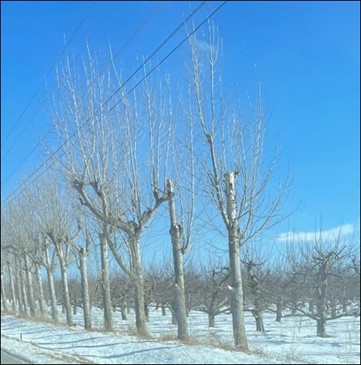
Using windbreaks to support pollinator health
When choosing the species of trees to plant in a windbreak, consider trees that will support pollinators and other wildlife. Trees that produce pollen, nectar or both can be excellent sources of nutrition to bees and other beneficial insects. Pollen provides bees with protein, fats, vitamins and minerals important for bee development, and nectar provides carbohydrates that bees use to generate energy. Growers can support bee health and crop pollination by incorporating flowering plants for bees on their farms, especially in agricultural areas that may not have enough flowers to support local pollinators.
Managed bees like honey bees and bumble bees that are brought into a farm or orchard for pollination can benefit from flowers outside of the crop, as these flowers can provide a more balanced diet that they need to grow their colonies. Beekeepers can provide food to honey bees by putting syrup and protein supplements in the hive to prevent the bees from starving, but it is better for bees when the landscape provides adequate nutrition.
Flowering plants on a farm can also support local, wild bee populations that may contribute to crop pollination. Wild bee species are completely dependent on food from flowering plants in the landscape. These bees need nutrition from flowers in bloom before and after a crop blooms, and they also need to have undisturbed nesting sites. They also need undisturbed areas for nesting and overwintering, such as bare ground, stems, brushy areas, or cavities, depending on the species of bee.
Selecting pollinator supportive trees for windbreaks
Selecting multiple species with different mature heights is ideal. When selecting woody plants for a farm or orchard windbreak, consider trees and shrubs that:
- Provide habitat to bees and other wildlife, including those that provide nectar, pollen or both to bees.
- Are strong and sturdy to hold up to strong wind.
- Do not have berries, which may act as hosts to spotted wing Drosophila.
- Are suited to the farm’s climate zone.
- Are not invasive or problematic.
- Are not prone to pests or diseases that may require pesticide applications.
- Are not challenging to plant or establish.
Michigan State University Extension suggest including a wide variety of species that vary in mature heights to help protect the crop from wind.
Trees for farm and orchard windbreaks that can be excellent sources of pollen or nectar for bees
Catalpa trees
Catalpa trees have large blossoms and provide nectar for bees. The tree itself is also large (over 40 feet mature height). This species is tolerable of a range of site conditions, but it is also prone to weak wood and branch structure if not mindfully pruned.
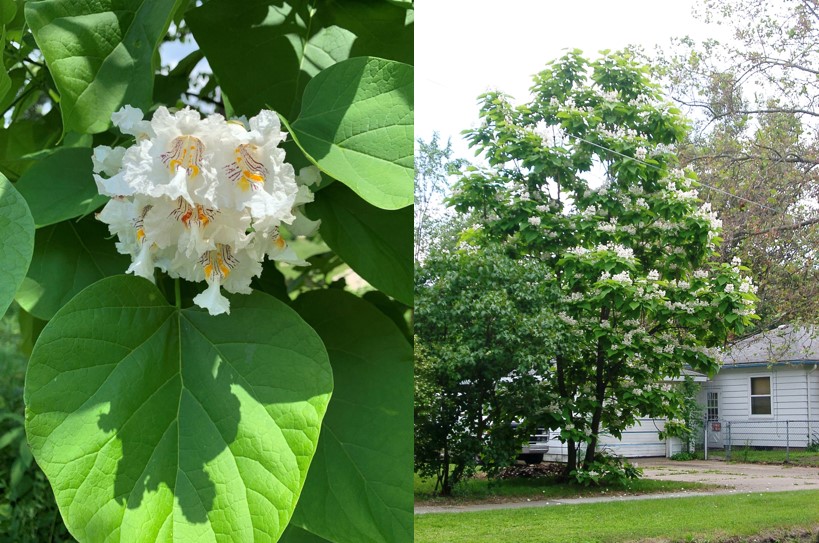
Lindens (Tilia spp.)
Also known as basswood trees, lindens can be an excellent source of nectar to bees. Honey bees can produce a nice crop of surplus honey from linden trees under the right conditions. Basswood honey is a desirable honey flavor to many consumers; the honey is light in color and fruity in flavor with notes of mint and green apple.
When selecting lindens, we recommend American basswood (Tilia americana) and little-leaved linden (Tilia cordata). These trees are large sized trees when mature (over 40 feet). American basswood trees tend to grow well in wetter areas.
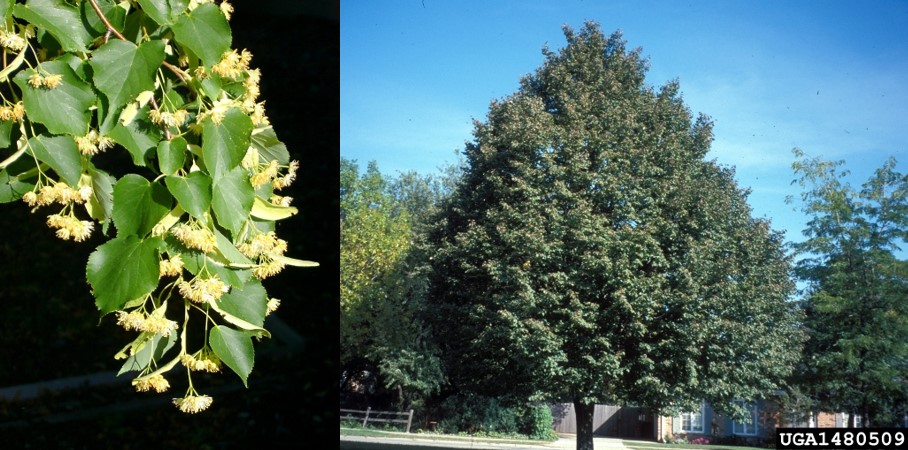
Maples
Maple trees are large trees (over 40 feet at maturity) that can be an excellent source of early-season pollen for bees. Depending on the weather and climate, they can also occasionally be a source of early-season nectar to bees.
Sugar maples (Acer saccharum) and red maples (Acer rubrum) are good options for a windbreak. If choosing red maples, avoid hybrids because many are sterile and do not have flowers. We suggest avoiding silver maples (Acer saccharinum) because they tend to have poor branch angles and do not handle ice storms or wind very well. We also recommend avoiding Norway maples (Acer platanoides) because they can be invasive.
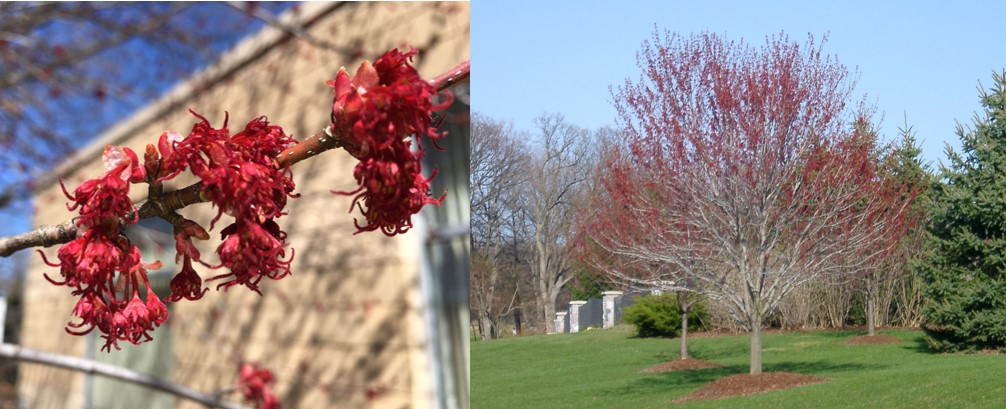
Redbuds
Redbud is a smaller tree species (up to 30 feet at maturity) that is early to flower. It produces pods rather than fruit. Many different species of bees find their blossoms attractive. In the first winter, protection is critical to helping redbud trees survive.
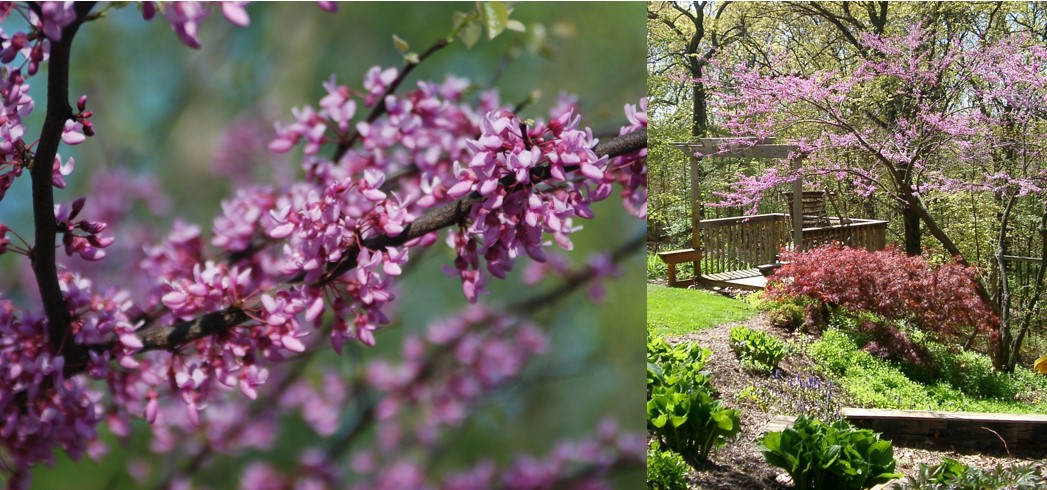
Sumacs
Sumacs, especially winged sumac (Rhus copallina) provide nectar and pollen for bees. Sumacs (Rhus) are not poisonous. (Poison sumac, Toxicodendron, is a distant cousin of Rhus and is only found in wet areas.)
In Michigan, sumacs bloom in the summer when there is often a dearth, or less nectar available, to bees from other plants. These are colony forming species that are tolerant of diverse site conditions. They are considered large shrubs or compact trees (up to 25 feet).
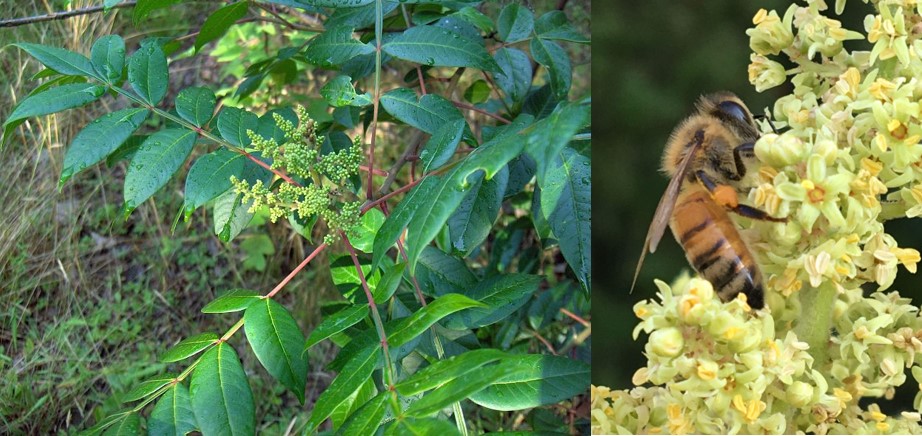
Tuliptrees (Liriodendron tulipifera)
Tuliptrees can be a great source of nectar for bees. They are fast-growing trees that can grow to be 70-90 feet. Be sure to choose tuliptrees with the genus name Liriodendron, not the genus Magnolia. Both belong to the same family (Magnoliaceae), but Liriodendron tulipifera is native to our region. Liriodendron tulipifera does best in soils that are well drained but receive consistent watering.
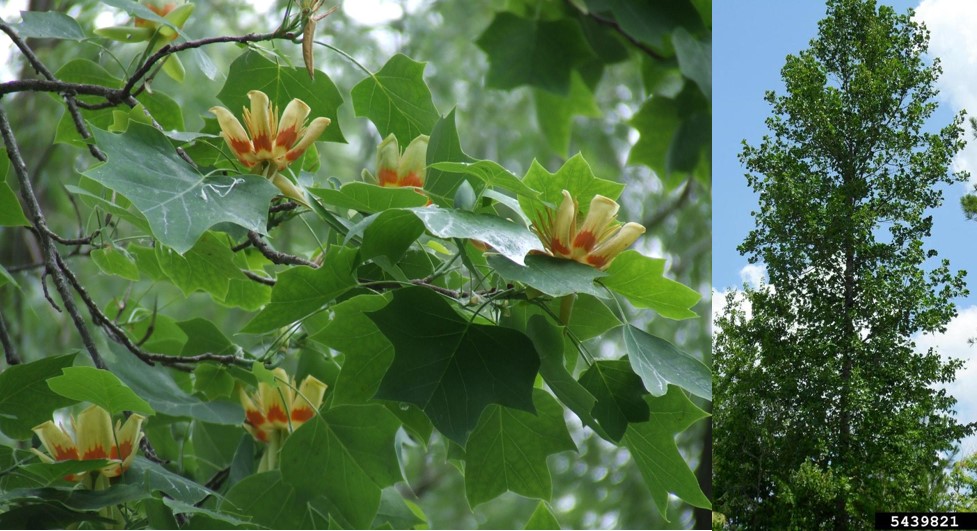
Tupelo trees (Nyssa sylvatica)
Tupelo trees provide nectar for bees. They are a medium to large tree (30-50 feet mature height) that flowers in the spring. A bonus is that their leaves provide beautiful fall colors. This species is dioecious with male and female flowers on separate trees. We suggest only planting male trees since female trees produce a dark purple fruit that may be a host to insect pests.
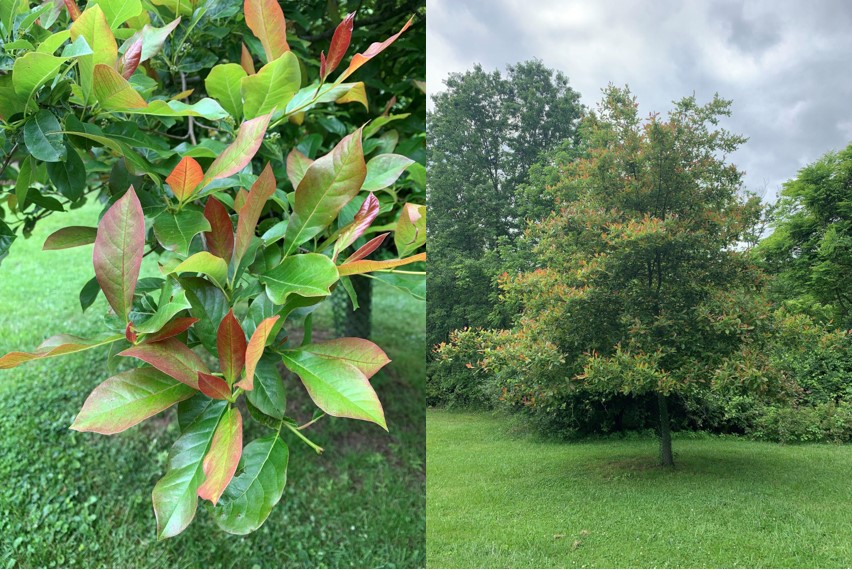
Willows
There is a wide range of willow species and hybrids that can fit most soil moisture and sun exposure situations. Willows are early to flower and can be an excellent source of pollen to bees coming out of their overwintering. A couple of good options are goat willows (Salix caprea) and pussy willow shrubs (Salix discolor). Avoid black willows (Salix nigra) that may not stand up to the wind. Also avoid ornamentals because many are sterile. Willows can also be easily propagated from cut dormant shoots, allowing growers to spread them out along a windbreak.
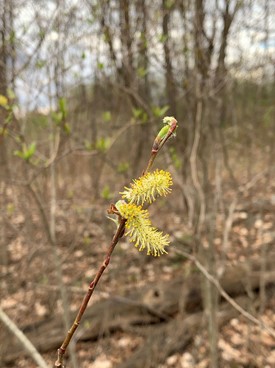
Other woody plants for windbreaks that can provide wildlife habitat
Windbreaks can also serve as wildlife corridors. Woody plants like the ones above not only provide pollen and nectar for bees, but also habitat for bee species and other wildlife. Habitat is important because it gives these creatures a place to carry out their life cycles. A supportive habitat will have space for foraging, nesting and overwintering. It will provide an area for seeking shelter from predators and harsh weather conditions.
Plants play a critical role in creating a supportive habitat by providing these services. The list below highlights some additional plant species that can be considered for windbreaks that may provide habitat for pollinators and birds. It includes some native and non-native species and a range of sizes. Rosaceous species (ornamental apple, cherry, etc.) were not included because of the potential to host pests and diseases.
Shrubs
- American hazelnut (Corylus americana)*
- Witch-hazel (Hamamelis virginiana)*
- Buttonbush (Cephalanthus occidentalis)*
- Bottlebrush buckeye (Aesculus parviflora)*
- Ninebark (Physocarpus opulifolius)*
- Korean lilacs (Syringa meyeri or Syringa palibiniana)
- Panicle hydrangea (Hydrangea paniculata)
Trees
- Silverbell (Halesia carolina)*
- Kentucky coffeetree (Gymnocladus dioicus)*
- Horse chestnut (Aesculus hippocastanum)
- Red horse-chestnut (Aesculus x carnea)
- Ohio buckeye (Aesculus glabra)*
- Yellow buckeye (Aesculus flava)*
- Amur maackia (Maackia amurensis)
- Chinese chestnut (Castanea mollissima)
- Dunstan chestnut (hybrid, mostly American chestnut genes)
- Tree lilac (Syringa reticulata)
- Japanese pagoda tree (Sophora japonica)
- Yellowwood (Cladrastis kentukea)*
- Golden rain tree (Koelreuteria paniculata)
*Denotes species native to North America.
Keeping pesticides away from bee supportive trees
Growers who include bee supportive trees and shrubs in or near their crops should take care not to get pesticides on the plants, especially when they are in bloom. Use drift mitigation strategies and integrated pest management practices. Use pesticides when wind speed is low to reduce drift. Calibrating sprayers can also help reduce pesticide drift. Apply pesticides only when needed, and they must be applied according to the label.
If you are looking to use a tree line to reduce pesticide drift on a farm, consider using conifers since they do not produce flowers that attract bees. Tree lines that reduce pesticide drift can provide safer spaces on the farm for bees, and they can also potentially screen adjacent properties or wildflower plantings from pesticide drift. Avoid allowing pesticides to drift onto flowers that bees and other beneficial insects may visit.
Additional resources
- Pollinator Supportive Trees from Michigan State University Pollinator Initiative
- Trees and Plants from The Morton Arboretum
- Trees for Bees and Other Pollinators from The Arbor Day Foundation
- Native Trees and Shrubs for Pollinators Chart by Heather Holm
Acknowledgments
Thank you to the Michigan Department of Agriculture and Rural Development for securing funding from the U.S. Environmental Protection Agency for Michigan State University to implement strategies in the Michigan Managed Pollinator Protection Plan.
This work is supported by the Crop Protection and Pest Management Program [grant no 2021-70006-35450] from the USDA National Institute of Food and Agriculture.
Any opinions, findings, conclusions, or recommendations expressed in this publication are those of the authors and do not necessarily reflect the view of the U.S. Department of Agriculture.



 Print
Print Email
Email




